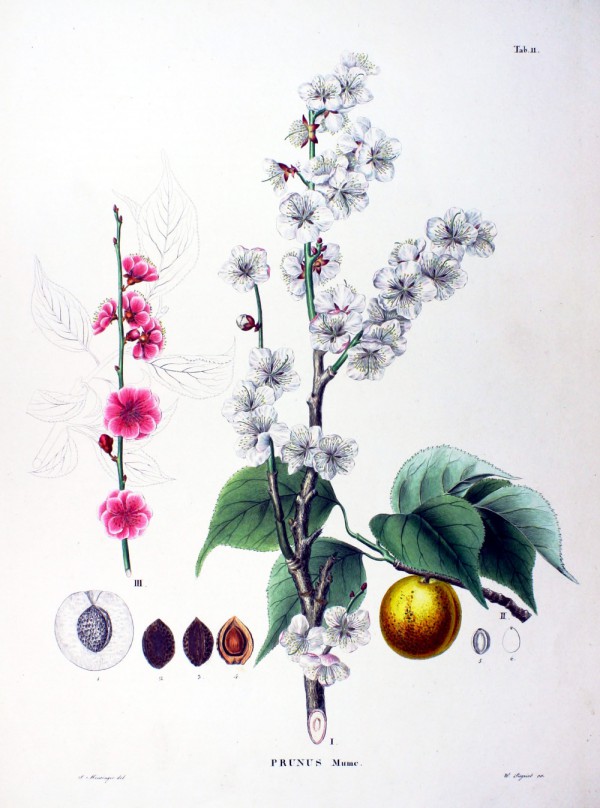Prunus mume Siebold & Zucc. - syn. Armeniaca mume Siebold - Rosaceae
梅 mei (chin.), mei flower, Chinese plum, Japanese apricot, Japanische Aprikose, Ume
Fruit tree, native to Eastern Asia (China, Korea, Japan, Laos, Vietnam, Thailand), widely cultivated for its flowers and for its edible fruits.
„Highly appreciated and admired for its early (January to March in central and southern China) blossoms, Prunus mume has enjoyed great popularity in China and Japan for centuries. It is popular as a bonsai and a 'must' in every Japanese-style garden. The world famous Kairaku-en garden in Japan, for example, boasts 3,000 specimens including 100 different cultivars, which create a feast for the eye during the 'plum blossom' season in late February/early March. Due to its long history of cultivation and cultural significance, there are more than 300 known cultivars in China, which differ mainly in the colour of their flowers (which can be white, pink, red, purple or light green).
Although sometimes called 'Chinese plum', the closest relative of this species is the wild apricot (Prunus armeniaca). A synonym of Prunus mume is Armeniaca mume.“ http://www.kew.org/science-conservation/plants-fungi/prunus-mume-mume
fruit
„ The major characteristic aroma components of Japanese apricot fruit grown in Dayi county, Sichuan Province were determined by headspace solid-phase microextraction coupled with gas chromatography-mass spectrometry (HS-SPME-GC-MS) based on odor activity values (OAVs). The pattern of accumulation of the major aroma components was investigated by analysis of aroma precursors and their correlation with climate factors was analyzed. The results showed that ethyl butyrate, β-myrcene, ethyl 3-methyl-butyrate, benzaldehyde and nonanal were the major characteristic aroma substances of Japanese apricot fruit, and C6 and C9 compounds were the major aroma components“
[Liu, Min-xin, et al. „Analysis of the accumulation of major aroma components in Japanese apricot fruit (Prunus mume siebold et zucc.) during ripening.“ (2023): 344-351]
„…the characteristic volatile compounds of mature Japanese apricot fruit were (+)-limonene, linalool, damascenone, β-damascenone and nonanal, finding the basis for the fruity, floral and sweet aroma of the Japanese apricot fruit.“
[Li, Aoting, et al. „Identification and variation of specific volatile compounds during fruit development and postharvest stage in Japanese apricot (Prunus mume Sieb. et Zucc.) fruit.“ Flavour and Fragrance Journal 39.5 (2024): 282-292]
„By application of an aroma extract dilution analysis (AEDA) on each aroma concentrate of Um liquors, total 17 peaks on gas chromatograms were detected in the flavor dilution (FD) factor range of 2 to 256. Those high FD factors revealed the following compounds as odor-active odorants in Ume liquor aroma, ethyl 2-methylbutanoate (fruity), benzaldehyde (processed Ume-like), phenylacetaldehyde (rose-like), vanillin (Vanilla-like), gamma-decalactone (fruity), delta-decalactone (peach-like), and gamma-undecalactone (peach-like). Koume liquor prepared from over-mature fruit possessed a sweeter aroma caused by lactone compounds than other Koume liquors and a commercial Ume liquor produced from middle size fruit, however, odor-active odorants of four liquors were very similar.“
[Tokitomo, Y., S. Mukawa, and Y. Endo. „Flavor of ume liquor prepared from small ume fruit (Prunus mume Sieb. et Zucc.).“ Journal of the Japanese Society for Food Science and Technology (Japan) (2005)]
flower
Major volatiles of the headspace (solid-phase microextraction, HS-SPME) of mei flowers were benzyl acetate, eugenol, n-hexyl acetate and benzaldehyde. „Petals mainly produced fatty acid derivatives and aromatic compounds, while pollen emitted aromatic compounds. Sepals, nectar and gynoecium released more volatile compounds than those from petals and pollen. Monoterpenes were only found in sepals, nectar and gynoecium. Emission of low concentrations of eugenol and high concentrations of n-hexyl acetate at fully opened flowers provides signals to nectar-feeding honeybees.“
[Dynamics of fragrant compounds from Prunus mume flowers., Yinquan, Z., Huitang, P., Qixiang, Z., CaiBo, P., Ming, C., Journal of Beijing Forestry University, 32(4), 2010, 201-206]
„Benzyl acetate is the dominant compound determining the characteristic floral scent of P. mume. Furthermore, production of benzyl acetate is either low or absent in the flowers of Prunus plants that are non-aromatic. Our experiments indicate that, with sufficient benzyl alcohol, benzyl acetate can be abundantly biosynthesized in the flowers of some non-aromatic species. Benzyl alcohol is produced by the reduction of benzaldehyde, which is an intermediate product in the metabolic pathway of benzenoid compounds. The end product of benzaldehyde in these metabolic pathways is a determinant of the characteristic floral scent of Prunus plants. Although a large amount of benzaldehyde exists in the endogenous extracts of various Prunus species…, the non-aromatic species appear to lack the molecular apparatus for reducing benzaldehyde to benzyl alcohol or part of the benzyl alcohol is converted to other products due to the existence of competitive pathways.“
[A comparative analysis of characteristic floral scent compounds in Prunus mume and related species., Hao, R., Du, D., Wang, T., Yang, W., Wang, J., Zhang, Q., Bioscience, biotechnology, and biochemistry, 78(10), 2014, 1640-1647] http://www.tandfonline.com/doi/full/10.1080/09168451.2014.936346
The emisson amounts (μg·g−1 fresh weight per hour) of the floral volatiles (phenylpropanoids/benzenoids >95%) emitted from eight intraspecific cultivars of P. mume with white, pink and red flowers were: Benzaldehyde (1-34), benzyl alcohol (38-1094), methyl benzoate (tr-24), benzyl acetate (7-1691), estragole (0-9), cinnamyl alcohol (0-138), eugenol (88-406), methyleugenol (tr-32), cinnamyl acetate (0-810), and benzyl benzoate (0-157).
[Zhang, Tengxun, et al. „A comparative analysis of floral scent compounds in intraspecific cultivars of Prunus mume with different corolla colours.“ Molecules 25.1 (2019): 145]
„Six main metabolites, including benzaldehyde, methyl benzoate, benzyl acetate, eugenol, (E)-cinnamic alcohol, and 4-allylphenol, together with 2-nonenal, 3,4-dimethoxytoluene, and trans-β-Ionone were screened as differential compounds, owing to their higher contents and/or lower olfactory threshold, which endow an almond, cherry, phenolic, wintergreen, cananga odorata, floral, jasmine, hyacinth, cinnamon, clove, woody, medicinal, and violet fragrance to each variety, and greatly contribute to the aroma differences of six cultivars of P. mume blossom.“
[Li, Ting, Xi Zhao, and Xueli Cao. „Volatile Metabolome and Aroma Differences of Six Cultivars of Prunus mume Blossoms.“ Plants 12.2 (2023): 308] https://www.mdpi.com/2223-7747/12/2/308

Prunus mume, Siebold, P.F. von, Zuccarini, J.G., Flora Japonica, t.11 (1875)
http://plantgenera.org/species.php?id_species=1265982

Japanese apricot flowering in Kyoto (2006) wikimedia commons